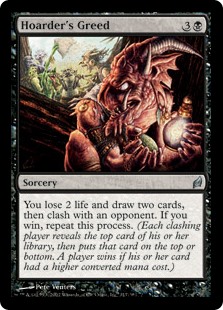Regardless of the style of game being played, I tend to be a fairly calculating person, continually processing what my best options are. This doesn’t take me so far down the road as to start number crunching statistical odds (usually), but I like to take stock of the situation in any given turn. I plan for contingency, figuring out backup options if my preferred strategy doesn’t pan out or if luck proves not to be in my favor. From Chess to Starcraft, poker to Magic, I weigh my options carefully, a battlefield tactician trying to factor as many moves and countermoves between myself and my opponents as possible. It can be frustrating to other players, admittedly, as this can easily lead to moments of analysis paralysis, but forging a path to victory while taking into account the actions of my opponents is part of what excites me about gaming.
It’s sort of like being Vizzini from The Princess Bride, minus the whole cheating and death bits.
However, that approach to gaming can also be tiring at times. The more complicated a game is, the more focus and mental fortitude is required. This is why I sometimes love digging into light casual games as a nice reprieve from the norm. Generally, the more casual a game is, the more the emphasis is on player interaction than on the rules, and it makes for a nice change of pace.
It’s not easy to adopt a more lackadaisical approach to Magic, a poster child for the typical style of game I gravitate towards, but it can be done in small doses. This include such things as playing with more casual-minded players and avoiding constantly min-maxing your decks by only putting in the most devastating and impacting cards along the power curve. Sometimes it’s fun to simply put a card in a deck because you like the artwork or you think its effect is amusing. And sometimes you simply want to throw calculated decision-making out the window entirely and take a gamble on the unknown. It can be quite refreshing to throw caution to the wind and say ‘screw it; let’s see what happens.’
Consequently, this week’s card is aimed at doing precisely that…mostly.
Today we have: Hoarder’s Greed

Name: Hoarder’s Greed
Edition: Lorwyn
Rarity: Uncommon
Focus: Card Draw
Highlights: Paying life to draw cards in Black has been around since the beginning, with notables like Greed and Necropotence. Starting with Ancient Craving during Portal Second Age, there have also been numerous variations on the now commonly seen “Sign in Blood” style Instants and Sorceries as well. Most tend to be derivatives of one another, each offering you cards (plus a few mana) at or around a 1:1 ratio of life to cards. From Skeletal Scrying to Read the Bones to Sanguimancy, these spells are helpful card acceleration – if you’re willing to pay the price.
Hoarder’s Greed is part of that same mentality, albeit one with a very block-centric rider, similar to Caress of Phyrexia. The difference is that while Hoarder’s Greed may be slightly below the curve compared to similar cards, its effect easily makes up for it.
In addition to drawing two cards for two life, Hoarder’s Greed’s Clash effect has two impacts on gameplay. First, it permits you and an opponent of your choice to Scry the top card of your decks, helping get rid of a potentially unwanted card. This alone can be advantageous if your next card wasn’t all that useful.
More importantly, if you win the Clash, you repeat the process of drawing cards, losing life, and Clashing all over again…until you either lose the Clash or the game. This is where the gambling comes into play.
If an opponent chooses to leave a land on the top of their deck, for instance, and you continually reveal anything but a CMC zero card, you can potentially gain a lot of cards and lose a lot of life for your troubles. In normal dueling, this potentiality made people justifiably reluctant to use it all that often. In multiplayer and Commander games, though, each time you repeat the Clash you can simply choose another opponent to Clash with and avoid such pitfalls.
At worst Hoarder’s Greed provides a minimum of two cards and a Scry effect, not unlike Read the Bones. More often than not though you can expect to draw at least 4-6, allowing you to draw more useful cards in the early game or to refill your hand quickly later on.
Yes, this card in the right (or wrong, as it were) circumstances can actually work against you, especially if you don’t have a lot of life to sacrifice to the Altar of the Card Gods. Such is the price of ambition. But quickly having a whole new set of card options outside of Blue should not be easily discounted. Losing eight life is painful, but it could just as easily provide you with exactly what you need.
The only way you’ll know for sure is to say screw it and see what happens.
Keep an eye out for us to be regularly featuring other more accessible-but-worth-it Commander cards going forward. In the meantime, we’ll keep the light on for you.
![]()
You can discuss this article over on our social media!
Do you have a particular Commander card to suggest for us to shine a future Spotlight on? You can send suggestions to ryan@cardboardrepublic.com
